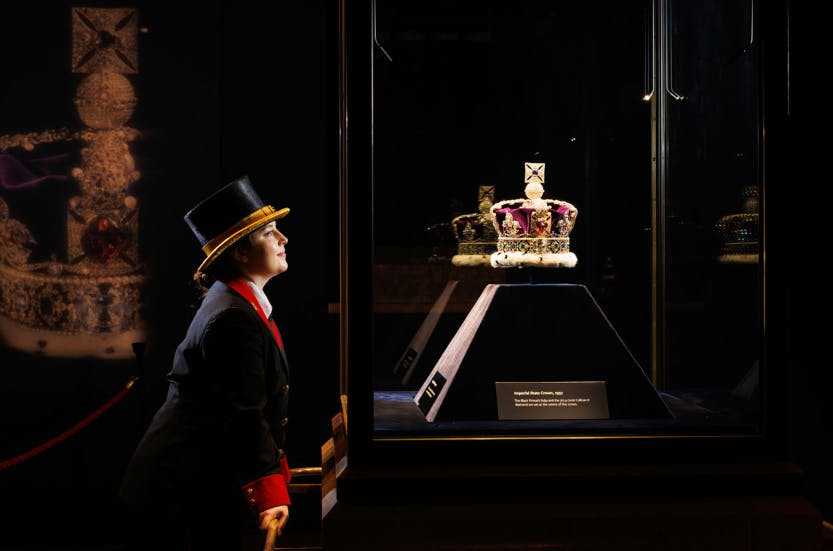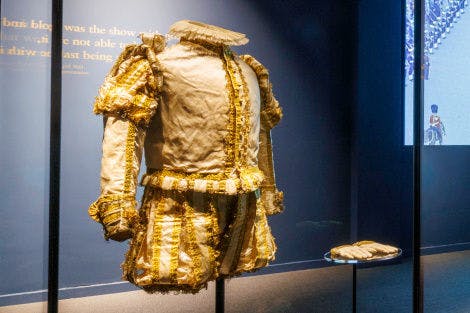Jewels On Display: A Short History of the Jewel House at the Tower of London
Date: 11 December 2023
Author: Tom Drysdale
The spectacular Crown Jewels exhibition in the Jewel House at the Tower of London showcases these celebrated symbols of monarchy. This year we unveiled a new permanent display, exploring the origins of these extraordinary objects in detail for the first time. But the Regalia hasn't always been displayed in such splendour.
Here, Tom Drysdale, Archivist and Curator of Architectural Drawings at the Tower of London, explores the fascinating history of this world-famous exhibition.

'These Wonderful Curiosities' in the 18th century
One 18th-century visitor to the Martin Tower, where the jewels had been kept since around 1668, described the old Jewel House as a ‘gloomy and cramped den’, while another called it ‘a dismal hole resembling the cell of the condemned’.
Image: The Crown Jewels on display in the Martin Tower. An engraving from Charles Knight's 'London', 1842. © Historic Royal Palaces
In the Georgian period, the experience of seeing the Crown Jewels took the form of an interactive theatrical spectacle. Visitors sat on benches and were subjected to a presentation on the history of the jewels delivered by a custodian. As one spectator recalled:
‘the woman [custodian] takes some sceptres and crowns out of a couple of old boxes, shows them to [the visitor] through an iron grate, and chants with a shrill voice the list and story of these wonderful curiosities, with which the whole farce is most stupidly concluded.’
Incredibly, following the presentation visitors were invited to reach through the iron grille and handle the regalia!
In 1840-41 a brand-new Jewel House was built to the south of the Martin Tower. The new building promised secure accommodation for the Crown Jewels. But it turned out to be damp, poorly lit, insecure and vulnerable to fire, and it wasn’t long before the Tower’s authorities were seeking a new home for the collection.
Image: 'South West View of the New Jewel House in the Tower of London', 1841. © Historic Royal Palaces

Custodians of the Crown Jewels in the 19th century
The custodian described by a visitor in 1821 was one of several women to hold the position, later formalised under the title of ‘Exhibitor’. Sarah Jane Werner, who described herself as ‘Show Exhibitress of Crown Jewels in the Tower’, performed the role for 31 years until her death in 1900.
Werner's appointment coincided with the removal of the Crown Jewels to a new home in the Wakefield Tower, where today's visitors can see part of the Medieval Palace. This Tower was originally built between c.1220 and c.1240 as part of Henry III’s Royal Palace but had been used since 14th century as a Record Office, and more recently as lodgings.
The preparation of the building was directed by Anthony Salvin, the architect who started the ‘remedievalisation’ of the Tower in the 1850s with the restoration of the Beauchamp Tower.. Salvin replaced the original timber floor of the Wakefield Tower with a brick vault, at the same time creating a new footbridge to connect the Jewel House with the new residence for the Keeper of the Jewel House in the adjacent St Thomas’s Tower.
This position entailed responsibility for the security and exhibition of the Crown Jewels, and despite its medieval origins it was only formalised in the 19th century, when the Keeper was given a government salary.
Video: Tower of London's 19th century architectural plans
Watch Archivist and Curator of Architectural Drawings Tom Drysdale showcase rarely seen plans from Historic Royal Palaces' drawings collections that reveal the transformational work done at the Tower in this period.
Watch Archivist and Curator of Architectural Drawings Tom Drysdale showcase rarely seen plans from Historic Royal Palaces’s drawings collections that reveal the transformational work done at the Tower in this period.

Suffragette Leonora Cohen’s Protest at the Jewel House
The new display in the Wakefield Tower was a considerable improvement on the old one. Not all visitors, though, held the Regalia in high regard. In February 1913, Suffragette Leonora Cohen staged a protest in the Jewel House, smashing a display case containing the Order of Merit, no longer part of the collection at the Tower of London.
Concerns for the safety of the Regalia grew after the Irish Crown Jewels were stolen from Dublin Castle in 1907. The Office of Works, which was responsible for the security of the Jewel House, commissioned a new display case.
Designed by Chubb & Son Ltd, and embellished with royal symbols, the new steel case provided protection for the jewels for more than 50 years.
Image: 'The Wakefield Tower arch in 1919, showing the ground plan, block plan, elevation and selectional elevation.' © Historic Royal Palaces
A new home for the Jewel House
By the end of Queen Victoria's reign, the Tower was welcoming almost half a million visitors a year. The Wakefield Tower was increasingly unable to cope with the growing number of visitors, and soon a new home was being sought for the Crown Jewels.
One option under consideration from as early as 1937 was relocating the jewels to the basement of the White Tower. However, after the Second World War, attention turned to another scheme for a new building beside the Lanthorn Tower, a Victorian recreation of part of the Medieval Palace to the south of the White Tower. Drawings and a model of this scheme prepared in the 1950s show a single-storey building faced in stone, with an entrance vestibule leading to a large display area inside.
With a capacity of up to 8,000 visitors a day, the new building would have allowed more people than ever to see the Crown Jewels. But the Ministry’s reluctance to erect a new building at the Tower, combined with financial troubles, put an end to the Lanthorn scheme.
Image: The Crown Jewels on display in the upper Wakefield Tower. © Crown Copyright: Historic Royal Palaces:

Up Close: Proposed Jewel House designs in the Lanthorn Tower
View this high definition Gigapixel image of a design for a new Jewel House at the base of the Lanthorn Tower in 1950.
Discover more architectural drawings of the Tower of London from Historic Royal Palaces' archives, created in partnership with Google Arts & Culture.

Going Underground
A new Jewel House was still desperately needed. Politicians and tourists joined the Guild of Guide Lecturers – the predecessor of the association that awards Blue Badges to today’s tourist guides – adding their voices to calls for a solution.
A second new scheme was already in the planning before the end of the decade, this time proposing to situate the new Jewel House underground beneath Tower Green.
While the new scheme proved attractive, rising costs delayed the decision to proceed. When space became available in the Waterloo Barracks, the Tower’s authorities decided to move the Crown Jewels into a new purpose-built exhibition space beneath the Parade Ground instead. In 1994 the Jewels moved to their present home in the Waterloo Barracks, where they continue to draw millions of visitors every year.
Image: The Jewel House today. © Historic Royal Palaces
See the Crown Jewels
From a ‘gloomy den’ to pride of place in their current home, the Crown Jewels have occupied several different spaces within the Tower. As their fame grew over the years, so did the need for more space and better facilities to accommodate visitors. Despite the challenges of displaying these priceless treasures to the public, the Tower of London has been a safe home to the Crown Jewels for centuries and these star exhibits continue to impress and inspire visitors from around the world today.
Image: A Tower of London Warder in the new Jewel House exhibition. © Historic Royal Palaces
Tom Drysdale, Archivist and Curator of Architectural Drawings
Historic Royal Palaces

Related Posts

Royal Ceremonial Dress Collection in the Jewel House
26 June 2023
Curator Charles Farris introduces some of the amazing ceremonial dress now on display in the Jewel House exhibition.

Charles II's Coronation Procession from the Tower of London
24 April 2023
As the country prepares for the coronation of His Majesty King Charles III, our Curator of Historic Buildings, Alden Gregory, takes a look at the coronation of the last King Charles to sit on the throne and the last coronation in which the Tower of London played a starring role.

The New Constable of the Tower of London
04 October 2022
General Sir Gordon Messenger became the 161st Constable of the Tower of London in August 2022, succeeding General The Lord Nicholas Houghton. The role of the Constable is the most senior appointment at the Tower of London and dates back to the time of William the Conqueror and the Norman Conquest.
